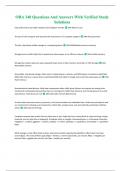OBA 340 Questions And Answers With Verified Study
Solutions
Chip performance per dollar doubles every eighteen months ANS Moore's Law
The part of the computer that executes the instructions of a computer program ANS Microprocessor
The fast, chip-based volatile storage in a computing device ANS RAM(Random Access-memory)
Storage (such as RAM chips) that is wiped clean when power is cut off from a device ANS Volatile memory
Storage that retains data even when powered down (such as flash memory, hard disk, or DVD storage) ANS
Nonvolatile memory
Nonvolatile, chip-based storage, often used in mobile phones, cameras, and MP3 players. Sometimes called flash
RAM, flash memory is slower than conventional RAM, but holds its charge even when the power goes out ANS
Flash memory
Semiconductor-based devices. Solid state components often suffer fewer failures and require less energy than
mechanical counterparts because they have no moving parts. RAM, flash memory, and microprocessors are solid
state devices. Hard drives are not ANS Solid state memory (Electronics)
A vision where low-cost sensors, processors, and communication are embedded into a wide array of products and
our environment, allowing a vast network to collect data, analyze input, and automatically coordinate collective
action ANS Internet of things
Computers express data as bits that are either one or zero. Eight bits form a byte (think of a byte as being a single
character you can type from a keyboard). A kilobyte refers to roughly a thousand bytes, or a thousand characters,
megabyte = 1 million, gigabyte = 1 billion, terabyte = 1 trillion, petabyte = 1 quadrillion, and exabyte = 1 quintillion
bytes
While storage is most often listed in bytes, telecommunication capacity (bandwidth) is often listed in bits per
second (bps). The same prefixes apply (Kbps = kilobits, or one thousand bits, per second, Mbps = megabits per
second, Gbps = gigabits per second, and Tbps = terabits per second)
, These are managerial definitions, but technically, a kilobyte is 210 or 1,024 bytes, mega = 220, giga = 230, tera =
240, peta = 250, and exa = 260. To get a sense for how much data we're talking about, see the table below ANS
Bits and bytes
Computers that are among the fastest of any in the world at the time of their introduction ANS
Supercomputers
A type of computing that uses special software to enable several computers to work together on a common
problem as if they were a massively parallel supercomputer ANS Grid computing
Replacing computing resources—either an organization's or individual's hardware or software—with services
provided over the Internet
Cloud computing is reshaping software, hardware, and service markets and is impacting competitive dynamics
across industries ANS Cloud computing
A form of cloud computing where a firm subscribes to a third-party software and receives a service that is delivered
online ANS SaaS (Software as a Service)
The term disruptive technologies is a tricky one, because so many technologies create market shocks and catalyze
growth. Lots of press reports refer to firms and technologies as disruptive. But there is a very precise theory of
disruptive technologies (also referred to as disruptive innovation—we'll use both terms here) offered by Harvard
professor Clayton Christensen that illustrates giant-killing market shocks, allows us to see why so many once-
dominant firms have failed, and can shed light on practices that may help firms recognize and respond to threats.
In Christensen's view, true disruptive technologies have two characteristics that make them so threatening. First,
they come to market with a set of performance attributes that existing customers don't value. Second, over time
the performance attributes improve to the point where they invade established markets. [4] (See Figure 6.1 "The
Giant Killer".)
These at ANS Disruptive technologies
Those running big firms fail to see disruptive innovations as a threat not because they are dumb but, in many ways,
because they do what executives at large, shareholder-dependent firms should do: they listen to their customers
and focus on the bottom line. And because of the first characteristic mentioned, the majority of a firm's current
customers don't want the initially poor-performing new technology. The most disruptive technologies also often
have worse margins than the initially dominant incumbent offerings. Since these markets don't look attractive, big
firms don't dedicate resources to developing the potential technology or nurturing the needs of a new customer





